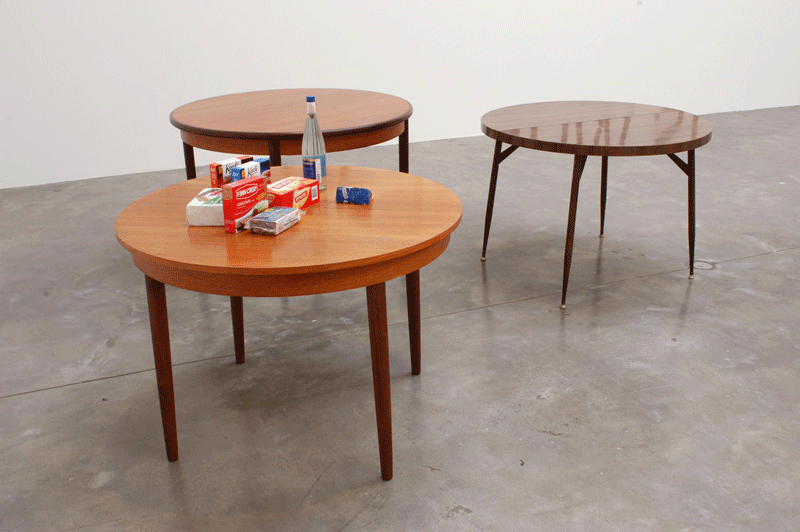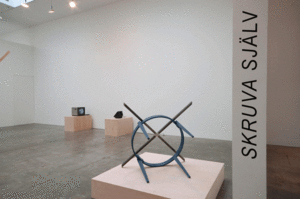This is an archive of the ArtCat Zine, 2007-2009. Please visit our new project, IDIOM.
On Bozidar Brazda; "Beat Meat Table Eat" at Bortolami Gallery
Beat Meat Table Eat
Bozidar Brazda
Bortolami Gallery - 510 W. 25th St, New York NY
25 October - 24 November 2007
In Meat Beat Table Eat Canadian artist Bozidar Brazda continues to expand the crude visual vocabulary he has been developing over the course of his solo exhibitions and curatorial projects. Using appropriation techniques, readymades, repetition, and text, Brazda quotes culture high and low to create immersive proto-narrative installations with very economic means, resisting the temptation to engage audiences with overly worked or crafty objects — this latter point perhaps a real feat in 2007. Brazda's work is challenging, and the rewards for scrutinizing observers are mixed. What's certain is that with each new exhibition the artist remains in dialog with himself — albeit this dialog may be more witty banter than any sort of serious interrogation. Take his obsession with wordplay, a clear homage to Bruce Nauman in several cases as critic Brian Sholis pointed out in Artforum last year. The “Beat” of the show's title could be the a reference to “The Beat,” a show of short, percussive looping videos Brazda curated in 2006. The masturbatory suggestion in “Meat” and “Beat” signals the artist's self-involvement and autobiographical mode, while "Meat" and "Eat" recall his last New York solo show, at the now defunct Haswellediger & Co., where he installed wall texts that played on these words. This sort of collection and noncommittal engagement with language carries over to the free multiple Brazda distributes at the show (something he has done in the past as well) taking form this time around as a "zine" on newsprint titled MOGENSEN — the name of both Danish pre-modernist furniture designer Borg Mogensen and minor Danish punk rocker Niels Mogensen.
The exhibition itself borrows several forms from the artist's previous work. The gallery is filled with a set of unmodified round tables that reveal their origin by way of their titles — one of which hangs inverted from the ceiling, wrapped with industrial chain in a way that the press release likens to a slab of meat, another slightly deconstracted and leaning against crossed metal beams — a small collection of Scandinavian crackers and other food products, two large vinyl wall texts, a chair with a stack of MOGENSEN for distribution, a short looping video, and a tailored suit made of clear plastic. The entire exhibition has a sort of stale, downtrodden “Eastern Bloc” feeling to it, and if one is at all familiar with the artist's previous work and the bits of autobiography Brazda lets trickle down to viewers, such a conclusion becomes irresistible. Nothing is glossy or fresh, everything from the design of the objects on display to the visual forms of the deconstructed table feels expired, slightly outmoded.
The tables, particularly the inverted one, echo the upholstered chair and overturned table in Brazda's last show at Haswellediger and expand the Nauman reference by evoking the inverted chairs from many of the artist's sculptures completed throughout the 80s, starting with South American Triangle, South America Square, and Diamond Africa with Chair Tuned D E A D (all 1981). Brazda's insertion of a table into the dense web of Nauman references may playfully complete the senior conceptual artist's dining room set, but does Brazda teach us anything new about Nauman? What's at work here seems to be a collection of forms: Nauman and American conceptual art are no more important to the artist than Danish punk rock or Swedish furniture design. The consequent airy relations of these things to one another, if communicated at all, come across as highly contrived.

Courtesy of Bortolami Gallery.
In this way Brazda resists becoming an artist-scholar or social critic in favor of drawing from a personal mythology while reconstituting and expanding the public persona by way of which he exhibits art. Those bits and pieces from his work which successfully communicate meaning and bring together different bodies of knowledge — punk and modernism, for instance — only do so after primarily functioning as autobiographical tools for the artist. All of this tends to engender a lot of irreverent flirtation with signs. The red and white colors on the moving blanket upon which a chair and the MOGENSEN zines are stacked, for instance, might be a Polish flag, although it's hard to understand its significance among the Scandinavian furniture. When an excerpt from an email interview with Niels Mogensen argues for music as a historical document, “a form of time travel,” then why does Brazda madly strum his bass with so little affect in Line Jerk-Off, a looping video shot with a tawdry, in-camera digital effect that stretches the image into a goofy ellipse?
Yet for all this surface vacillation the work is certainly no weaker. If Brazda has in fact succeeded in creating a sort of mythic artistic persona as a radical Eastern European émigré unsure of where to invest his ideological roots — perhaps the legacy of an one-time escape from a failed instance of an unspecified socialist state (a grand modernist project in itself) — than what position can the artist safely occupy but a liminal one? There are no concessions to singularity or the unequivocal expression here. If his work is indeed offhandedly opaque, it is because the artist's own identity and the context in which he exhibits is incredibly problematized. Perhaps SKRUVA SJÄLV is the clearest metaphor for the artist's working process: a wall text in Swedish expressing roughly punk's “do it yourself” tag line but translating to English literally as “screw yourself” (and also an Ikea Sweden slogan). In this manner Brazda can't help but bastardize his own cultural reference points, continually caught between colliding language and value systems.
ZINE
HOME
TIPS / COMMENTS
CATEGORIES
CONTRIBUTORS
- Greg Afinogenov
- B. Blagojevic
- Adda Birnir
- Susannah Edelbaum
- Julie Fishkin
- Paddy Johnson
- Jessica Loudis
- Christopher Reiger
- Andrew Robinson
- Peter J. Russo
- Blythe Sheldon
- S.C.Squibb
- Hrag Vartanian

